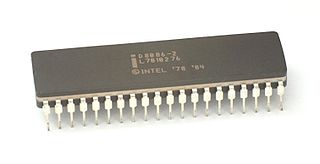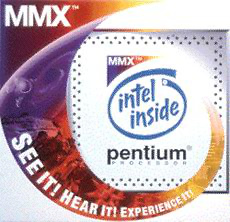Related Research Articles

Advanced Micro Devices, Inc. (AMD) is an American multinational semiconductor company based in Santa Clara, California, that develops computer processors and related technologies for business and consumer markets.

Athlon is the brand name applied to a series of x86-compatible microprocessors designed and manufactured by AMD. The original Athlon was the first seventh-generation x86 processor and the first desktop processor to reach speeds of one gigahertz (GHz). It made its debut as AMD's high-end processor brand on June 23, 1999. Over the years AMD has used the Athlon name with the 64-bit Athlon 64 architecture, the Athlon II, and Accelerated Processing Unit (APU) chips targeting the Socket AM1 desktop SoC architecture, and Socket AM4 Zen microarchitecture. The modern Zen-based Athlon with a Radeon Graphics processor was introduced in 2019 as AMD's highest-performance entry-level processor.

The Cyrix 6x86 is a line of sixth-generation, 32-bit x86 microprocessors designed and released by Cyrix in 1995. Cyrix, being a fabless company, had the chips manufactured by IBM and SGS-Thomson. The 6x86 was made as a direct competitor to Intel's Pentium microprocessor line, and was pin compatible. During the 6x86's development, the majority of applications performed almost entirely integer operations. The designers foresaw that future applications would most likely maintain this instruction focus. So, to optimize the chip's performance for what they believed to be the most likely application of the CPU, the integer execution resources received most of the transistor budget. This would later prove to be a strategic mistake, as the popularity of the P5 Pentium caused many software developers to hand-optimize code in assembly language, to take advantage of the P5 Pentium's tightly pipelined and lower latency FPU. For example, the highly anticipated first-person shooter Quake used highly optimized assembly code designed almost entirely around the P5 Pentium's FPU. As a result, the P5 Pentium significantly outperformed other CPUs in the game.

The K6 microprocessor was launched by AMD in 1997. The main advantage of this particular microprocessor is that it was designed to fit into existing desktop designs for Pentium-branded CPUs. It was marketed as a product that could perform as well as its Intel Pentium II equivalent but at a significantly lower price. The K6 had a considerable impact on the PC market and presented Intel with serious competition.

x86 is a family of complex instruction set computer (CISC) instruction set architectures initially developed by Intel based on the Intel 8086 microprocessor and its 8088 variant. The 8086 was introduced in 1978 as a fully 16-bit extension of Intel's 8-bit 8080 microprocessor, with memory segmentation as a solution for addressing more memory than can be covered by a plain 16-bit address. The term "x86" came into being because the names of several successors to Intel's 8086 processor end in "86", including the 80186, 80286, 80386 and 80486 processors. Colloquially, their names were "186", "286", "386" and "486".

MMX is a single instruction, multiple data (SIMD) instruction set architecture designed by Intel, introduced on January 8, 1997 with its Pentium P5 (microarchitecture) based line of microprocessors, named "Pentium with MMX Technology". It developed out of a similar unit introduced on the Intel i860, and earlier the Intel i750 video pixel processor. MMX is a processor supplementary capability that is supported on IA-32 processors by Intel and other vendors as of 1997.
In computing, Streaming SIMD Extensions (SSE) is a single instruction, multiple data (SIMD) instruction set extension to the x86 architecture, designed by Intel and introduced in 1999 in their Pentium III series of central processing units (CPUs) shortly after the appearance of Advanced Micro Devices (AMD's) 3DNow!. SSE contains 70 new instructions, most of which work on single precision floating-point data. SIMD instructions can greatly increase performance when exactly the same operations are to be performed on multiple data objects. Typical applications are digital signal processing and graphics processing.

The Athlon 64 is a ninth-generation, AMD64-architecture microprocessor produced by Advanced Micro Devices (AMD), released on September 23, 2003. It is the third processor to bear the name Athlon, and the immediate successor to the Athlon XP. The Athlon 64 was the second processor to implement the AMD64 architecture and the first 64-bit processor targeted at the average consumer. Variants of the Athlon 64 have been produced for Socket 754, Socket 939, Socket 940, and Socket AM2. It was AMD's primary consumer CPU, and primarily competed with Intel's Pentium 4, especially the Prescott and Cedar Mill core revisions.
3DNow! is a deprecated extension to the x86 instruction set developed by Advanced Micro Devices (AMD). It adds single instruction multiple data (SIMD) instructions to the base x86 instruction set, enabling it to perform vector processing of floating-point vector operations using vector registers, which improves the performance of many graphics-intensive applications. The first microprocessor to implement 3DNow! was the AMD K6-2, which was introduced in 1998. When the application was appropriate, this raised the speed by about 2–4 times.

The K6-2 is an x86 microprocessor introduced by AMD on May 28, 1998, and available in speeds ranging from 266 to 550 MHz. An enhancement of the original K6, the K6-2 introduced AMD's 3DNow! SIMD instruction set and an upgraded system-bus interface called Super Socket 7, which was backward compatible with older Socket 7 motherboards. It was manufactured using a 250 nanometer process, ran at 2.2 volts, and had 9.3 million transistors.

The K6-III was an x86 microprocessor line manufactured by AMD that launched on February 22, 1999. The launch consisted of both 400 and 450 MHz models and was based on the preceding K6-2 architecture. Its improved 256 KB on-chip L2 cache gave it significant improvements in system performance over its predecessor the K6-2. The K6-III was the last processor officially released for desktop Socket 7 systems, however later mobile K6-III+ and K6-2+ processors could be run unofficially in certain socket 7 motherboards if an updated BIOS was made available for a given board. The Pentium III processor from Intel launched 6 days later.

The WinChip series was a low-power Socket 7-based x86 processor designed by Centaur Technology and marketed by its parent company IDT.
The AMD Family 10h, or K10, is a microprocessor microarchitecture by AMD based on the K8 microarchitecture. The first third-generation Opteron products for servers were launched on September 10, 2007, with the Phenom processors for desktops following and launching on November 11, 2007 as the immediate successors to the K8 series of processors.
References
- ↑ "AMD K6 microprocessor families". x86 CPUs' Guide. Gennadiy Shvets. 2003–2021. Retrieved May 29, 2022.
- ↑ "The PC Guide". AMD K6. Charles M. Kozierok. April 17, 2001. Archived from the original on January 25, 2019. Retrieved May 29, 2022.
- 1 2 3 "AMD Introduces Sixth-Generation AMD-K6™ MMX Processor" (Press release). Advanced Micro Devices, Inc. April 2, 1997. Archived from the original on October 6, 2001. Retrieved May 29, 2022.
- 1 2 "AMD Begins Shipments of AMD-K6® Processors Utilizing Quarter-Micron Process Technology" (Press release). Advanced Micro Devices, Inc. January 6, 1998. Archived from the original on June 3, 2002. Retrieved May 29, 2022.
- ↑ "AMD Introduces 300-Megahertz AMD-K6® Processor" (Press release). Advanced Micro Devices, Inc. April 7, 1998. Archived from the original on June 3, 2002. Retrieved May 29, 2022.
- ↑ "AMD K6-2 microprocessor families". x86 CPUs' Guide. Gennadiy Shvets. 2003–2021. Retrieved May 29, 2022.
- 1 2 3 "AMD Introduces AMD-K6®-2 Processor with New 3DNow!™ Technology" (Press release). Advanced Micro Devices, Inc. May 28, 1998. Archived from the original on March 15, 2010. Retrieved May 29, 2022.
- ↑ "AMD Announces Shipments Of 350MHz AMD-K6®-2 Processor With 3DNow!™ Technology" (Press release). Advanced Micro Devices, Inc. August 27, 1998. Archived from the original on March 17, 2010. Retrieved May 29, 2022.
- 1 2 3 "AMD Introduces 400 MHz AMD-K6®-2 Processor with 3DNow!™ Technology" (Press release). Advanced Micro Devices, Inc. November 16, 1998. Archived from the original on March 15, 2010. Retrieved May 29, 2022.
- ↑ "AMD Introduces 450-MHz AMD-K6®-2 Processor With 3DNOW!™ Technology" (Press release). Advanced Micro Devices, Inc. February 26, 1999. Archived from the original on March 18, 2010. Retrieved May 29, 2022.
- ↑ "AMD Introduces 475-MHz AMD-K6®-2 Processor With 3DNOW!™ Technology" (Press release). Advanced Micro Devices, Inc. April 5, 1999. Archived from the original on March 18, 2010. Retrieved May 29, 2022.
- ↑ "AMD Introduces 500MHz AMD-K6®-2 Processor With 3DNow!™ Technology" (Press release). Advanced Micro Devices, Inc. August 30, 1999. Archived from the original on March 18, 2010. Retrieved May 29, 2022.
- ↑ "AMD Introduces 533MHz AMD-K6® -2 Processor With 3DNOW!™ Technology" (Press release). Advanced Micro Devices, Inc. November 29, 1999. Archived from the original on March 2, 2010. Retrieved May 29, 2022.
- ↑ "AMD Introduces 550MHz AMD-K6® -2 Processor with 3DNOW!™ Technology" (Press release). Advanced Micro Devices, Inc. June 26, 2000. Archived from the original on March 18, 2010. Retrieved May 29, 2022.
- ↑ "AMD K6-III microprocessor families". x86 CPUs' Guide. Gennadiy Shvets. 2003–2021. Retrieved May 29, 2022.
- 1 2 "AMD INTRODUCES INDUSTRY-LEADING AMD-K6®-III PROCESSOR WITH 3DNOW!™ TECHNOLOGY" (Press release). Advanced Micro Devices, Inc. February 22, 1999. Archived from the original on August 1, 2001. Retrieved May 29, 2022.
- ↑ "AMD Announces AMD-K6® /300 Processor for Mobile Computing" (Press release). Advanced Micro Devices, Inc. September 22, 1998. Archived from the original on May 24, 2006. Retrieved May 29, 2022.
- 1 2 3 "AMD Announces Mobile AMD-K6®-2 Family of Processors with 3DNow!™ Technology for Notebook Computing" (Press release). Advanced Micro Devices, Inc. January 13, 1999. Archived from the original on March 15, 2010. Retrieved May 29, 2022.
- 1 2 3 "AMD Introduces The Industry's Highest-Clock Speed Mobile PC Processor" (Press release). Advanced Micro Devices, Inc. March 8, 1999. Archived from the original on March 15, 2010. Retrieved May 29, 2022.
- ↑ "AMD Introduces 400MHz Mobile AMD-K6®-2-P Processor" (Press release). Advanced Micro Devices, Inc. June 15, 1999. Archived from the original on March 28, 2005. Retrieved May 29, 2022.
- 1 2 3 4 5 6 "AMD Expands Mobile Processor Family With Introduction Of World's Fastest x86 CPUs For Notebook Computing" (Press release). Advanced Micro Devices, Inc. September 20, 1999. Archived from the original on March 15, 2010. Retrieved May 29, 2022.
- 1 2 3 4 5 6 "AMD Introduces 0.18 Micron Mobile AMD-K6®-III+ and Mobile AMD-K6-2+ Processors" (Press release). Advanced Micro Devices, Inc. April 18, 2000. Archived from the original on March 13, 2009. Retrieved May 29, 2022.
- 1 2 "AMD Boosts Battery Life for Notebook Computers with AMD PowerNow!™ Technology" (Press release). Advanced Micro Devices, Inc. June 26, 2000. Archived from the original on May 4, 2008. Retrieved May 29, 2022.
- 1 2 3 "AMD Introduces Highest Performance x86 CPU For Notebook PCs" (Press release). Advanced Micro Devices, Inc. May 24, 1999. Archived from the original on November 20, 2009. Retrieved May 29, 2022.
- 1 2 3 "AMD Introduces The AMD-K6™-2E Processor, The First Embedded Processor With 3DNow!™ Technology and 100-MHz Frontside Bus SUPPORT" (Press release). Advanced Micro Devices, Inc. June 28, 1999. Archived from the original on August 25, 2001. Retrieved May 29, 2022.
- 1 2 3 "AMD Expands The AMD-K6®-2E Embedded Processor Family" (Press release). Advanced Micro Devices, Inc. December 6, 1999. Archived from the original on February 14, 2008. Retrieved May 29, 2022.
- 1 2 3 4 5 6 7 8 "AMD Introduces Powerful and Power Friendly AMD-K6™-2E+, AMD-K6™-IIIE+ Embedded Processors" (Press release). Advanced Micro Devices, Inc. September 25, 2000. Archived from the original on October 13, 2006. Retrieved May 29, 2022.